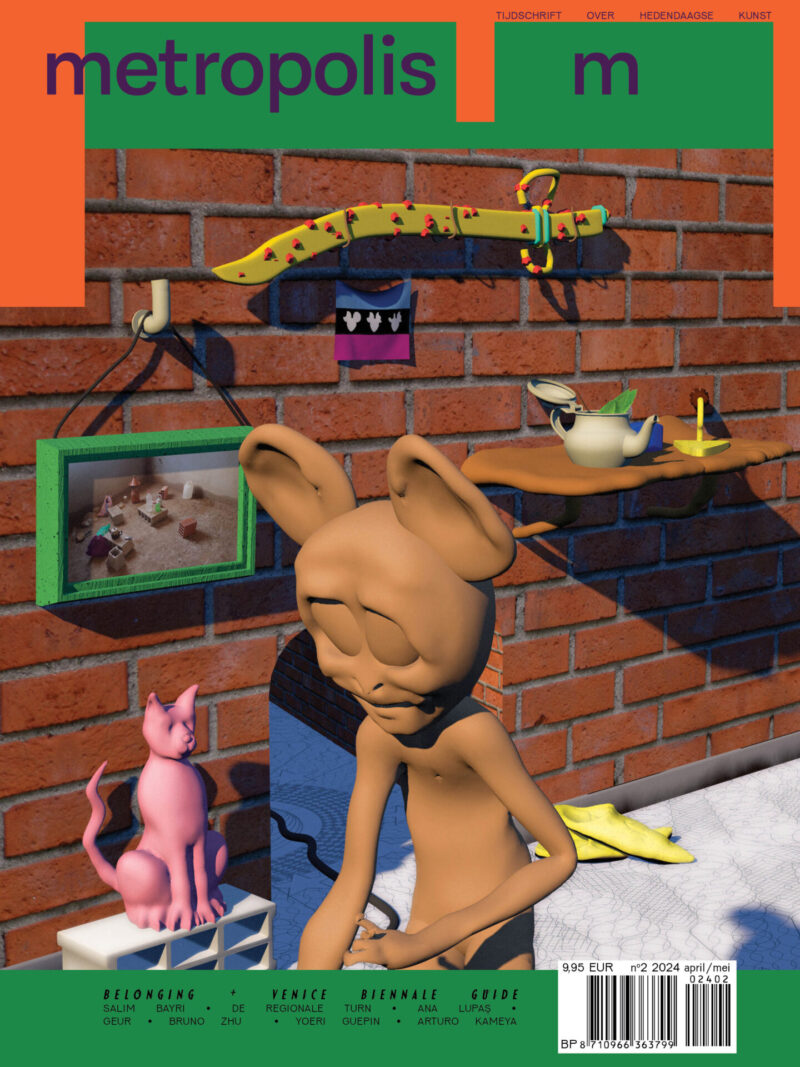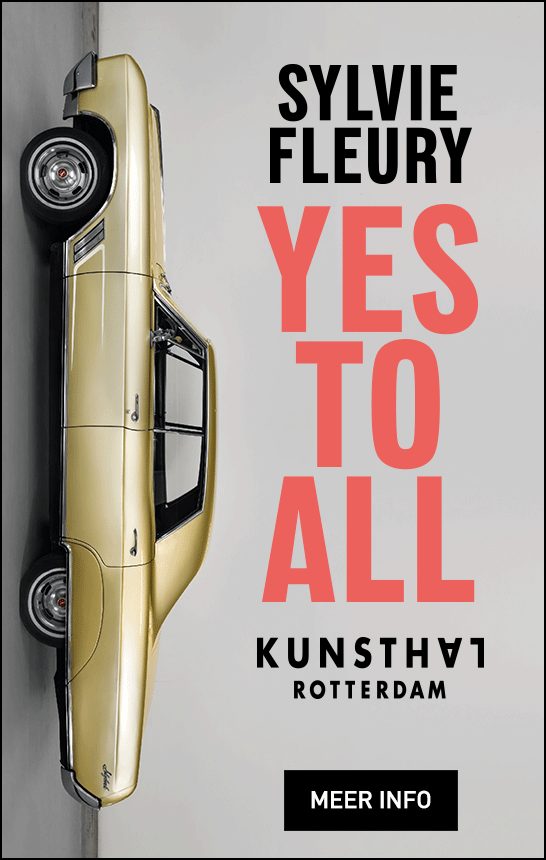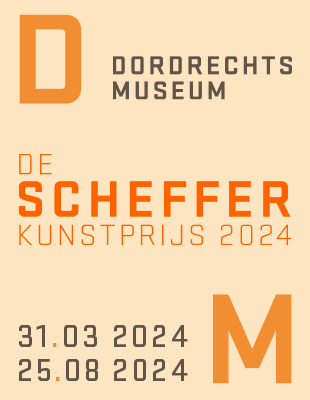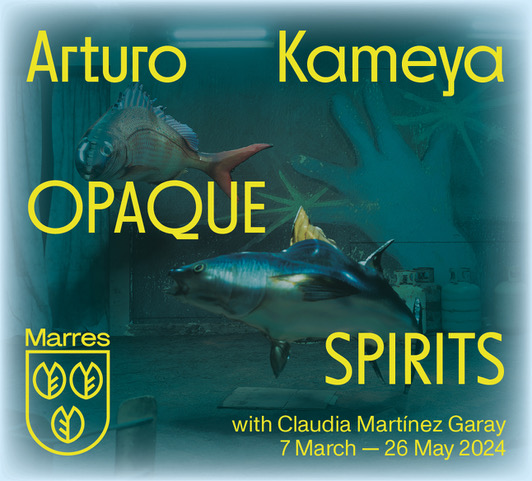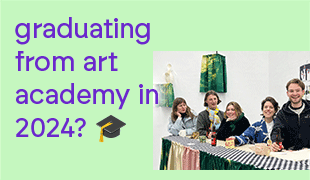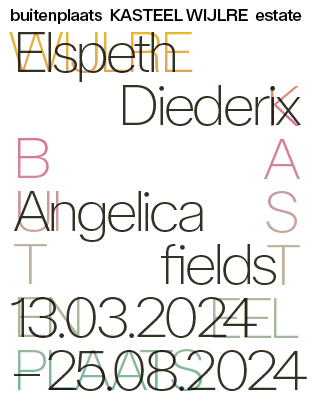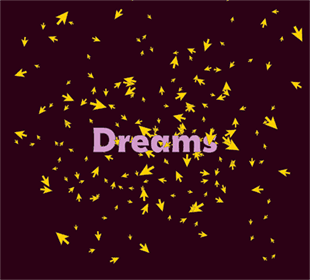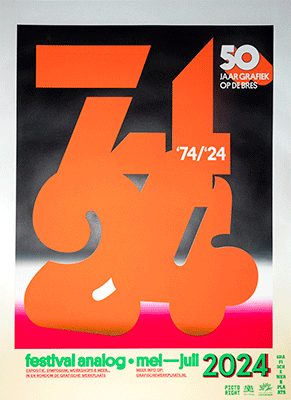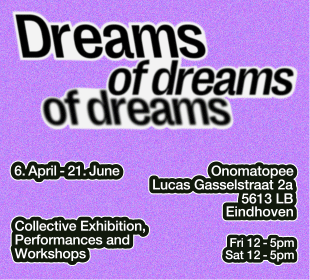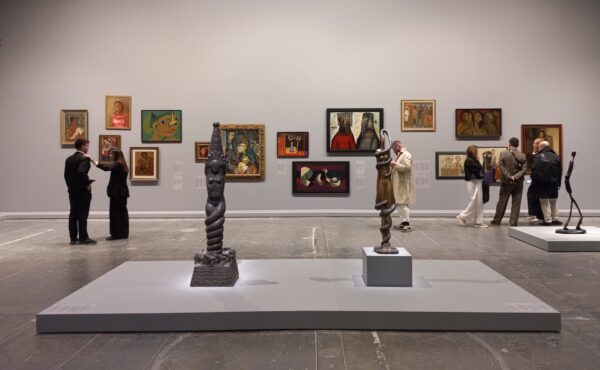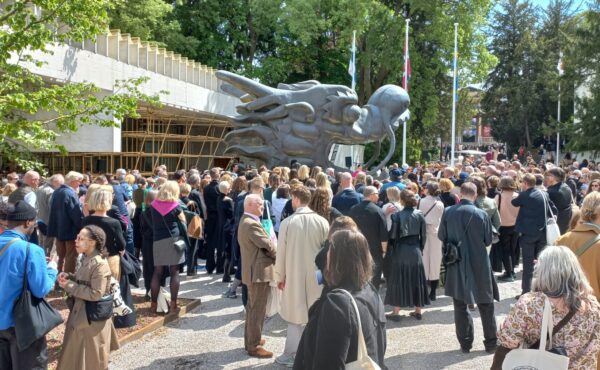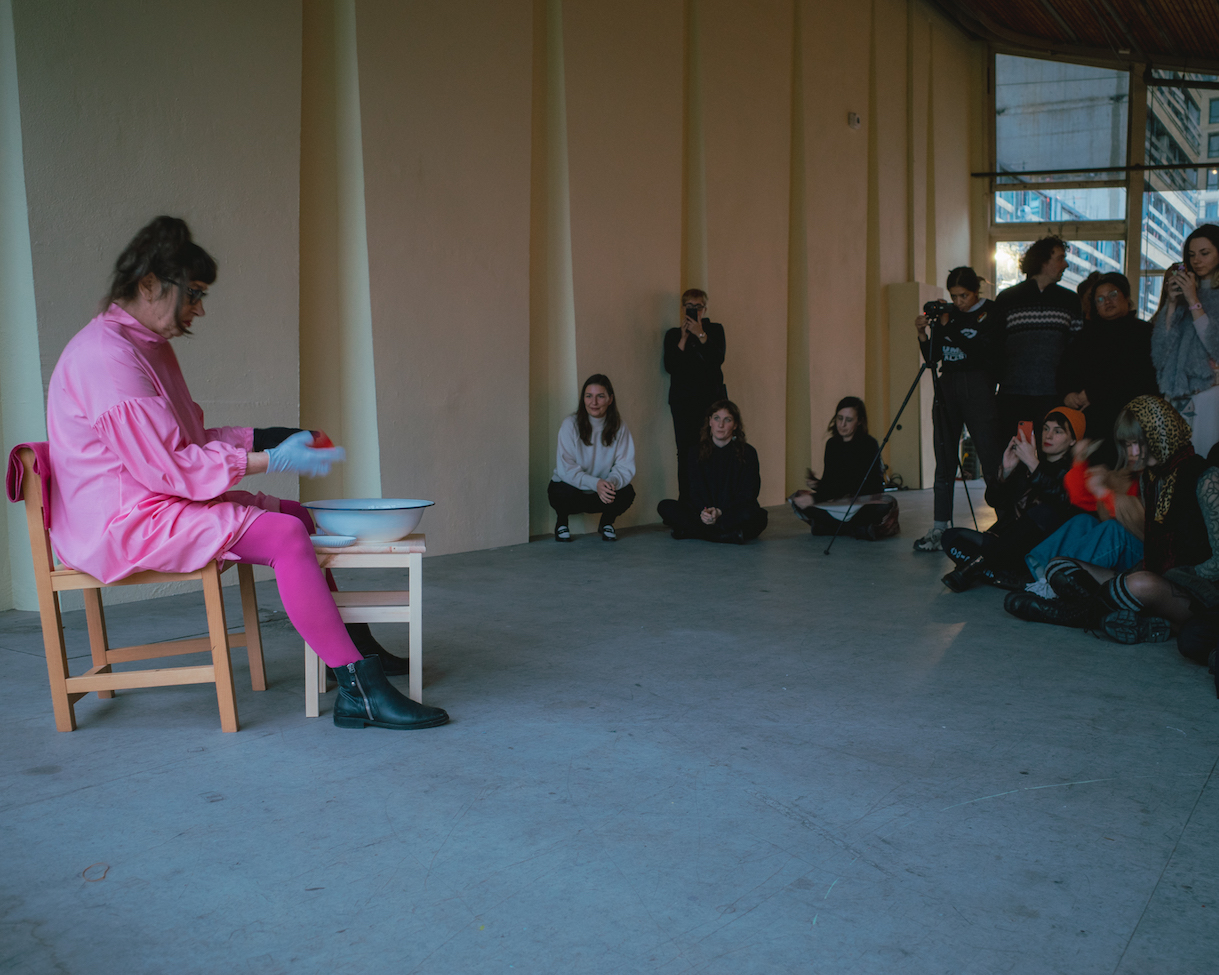
Bettina Bereś reenactment of Washing Hands
Female performance art in Poland: Dorothé Orczyk researches acts of artistic resistance between the 1960s and now
For her PhD research into performance art as resistance, Dorothé Orczyk looks into the artistic practice of four Polish female performance artists whose work revolves around the position of women: Natalia LL (1937-2022), Zofia Kulik (1947), Ewa Partum (1945) and Maria Pinińska-Bereś (1931-1999). To what extent could they be critical in Socialist Poland? How do current right-wing nationalist policies compare to those in place when they started their artistic careers? And what advice would they give the younger generation of artists?
Dorothé Orczyk’s deep-rooted interest in performance art dates back to her student time. While studying Art History at Utrecht University, she started working at Ellen de Bruijne Projects in Amsterdam, a gallery then known for representing female video and performance artists. Here, Orczyk was responsible for organizing exhibitions for the Dolores programme which offered young artists a platform. Among the events she curated were two performance festival editions aimed to present various forms of performance art, from lecture performances and participatory performances to club performances. ‘Curating and organizing these exhibitions, in combination with my regular work in the gallery, gave me much exposure to performance art. I gained substantive and practical knowledge of contemporary performance art’, says Orczyk. It was also during this period that she became familiar with the work of Pauline Bourdy & Renate Lorenz, Dora Garcia and Maria Pask, artists who would inspire her research into female socially engaged performance art.
In the years that followed, Orczyk collaborated on several projects that allowed her to further develop her social engagement. In 2016 and 2018, she organized two exhibitions at the Thomas Church and Community Centre in Amsterdam South – Love Hate Reparation by Snejanka Mihaylova and Sebastian Blu by Pauline Curnier Jardin – which revolved around women, religion, and society. Together with Sjoerd Kloosterhuis, Orczyk opened the Rozenstraat – a rose is a rose is a rose, an exhibition space in the premises of the former Stedelijk Museum Bureau Amsterdam where they collaborated with international artists working with video and performance art such as Michel Cardena and Grace Schwindt.
For Orczyk, ‘art is a sanctuary to critically reflect on society and a way to gradually change society.’ In this, performance art is seen as the most straightforward way of achieving this: ‘It is the most direct form of communication within all art disciplines’
For Orczyk, ‘art is a sanctuary to critically reflect on society and a way to gradually change society.’ In this, performance art is seen as the most straightforward way of achieving this: ‘It is the most direct form of communication within all art disciplines. Its physical manifestation triggers an immediate response from the audience.’ Over the years, Orczyk developed an interest in public performance, namely its ability to engage a wider audience outside the institutional art sphere and how it could incite change. But what made her focus on Polish female artists and pursue a PhD in performance art as female resistance in Poland?
Performance as female resistance in Poland
Growing up in the Netherlands with a Dutch father and Polish mother, Orczyk experienced the Cold War from the sidelines. Some of her childhood memories of this period include images of closed borders, the Soviet police walking on the streets of Poland and state-run shops. After the fall of the Berlin Wall in 1989, the Polish trade union movement Solidarność won the first democratic elections in the country and freed the population from the communist yoke: borders were opened, freedom of the press and political pluralism were introduced. But what did this freedom mean and what changes did it bring for women? And what significance does this still have today? These questions have lingered in Orczyk’s mind as she realizes how short collective memory can be: ‘Although it has been over 30 years since the fall of the Wall, we tend to take for granted what we have achieved and forget how easily we can lose it all again.’
In April 2019, a public protest in Warsaw against the removal of three artworks from the permanent collection galleries at the National Museum in Warsaw was the catalyst for Orczyk’s PhD research. The artworks in question were deemed indecent by Jerzy Miziołek, the museum director appointed by Poland’s right-wing government. Among them was Consumer Art (1972) a video by avant-garde artist Natalia LL, showing a model suggestively eating a banana and hotdog, foods which at the time were not available in local grocery shops. This artwork was perceived as heavily sexual and therefore considered harmful for vulnerable young people. In the days that followed, a large crowd of Polish artists and young people gathered in front of the museum and ate bananas as a way to protest against censorship. This simple act quickly became a subversive form of protest and an effective one too as the artworks returned to the museum galleries.

Agata Jakubowska
Orczyk has long been acquainted with the work of Natalia LL. Regular visits to museums in Wrocław, Orczyk’s second home, gave her valuable insights into the work of this and other female Polish artists and made her reflect on how they were perceived in the post-communist era: ‘LL’s work has always fascinated me. I was amazed by how these often sexually explicit works were purchased in today’s prudish and Catholic Poland.’
All the artists Orczyk researches were active during the period of the Polish People’s Republic. ‘Through archival research and studio visits, I want to investigate the context and conditions in which these artists worked from the 1960s to the Fall of the Berlin Wall’
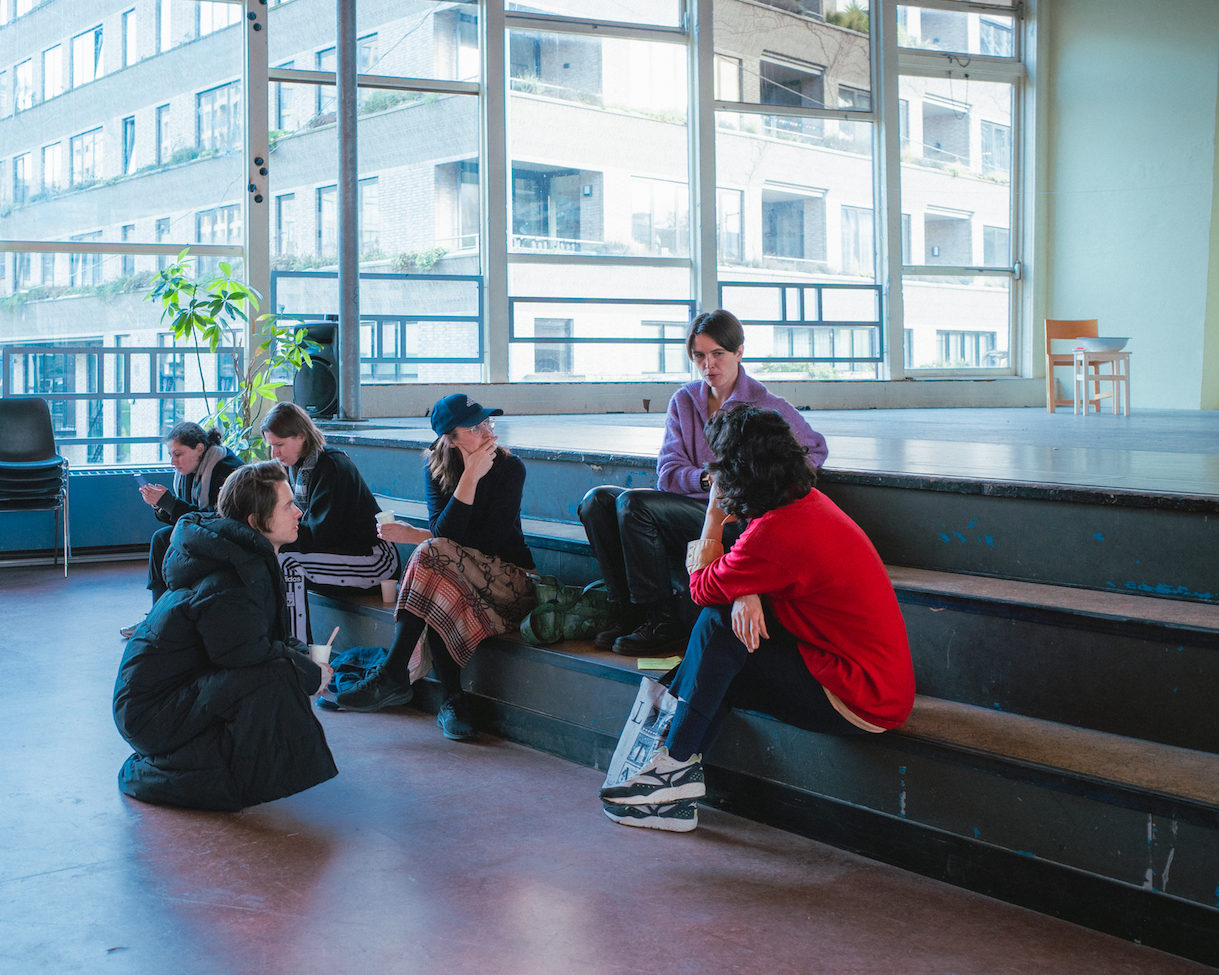
Audience during the break
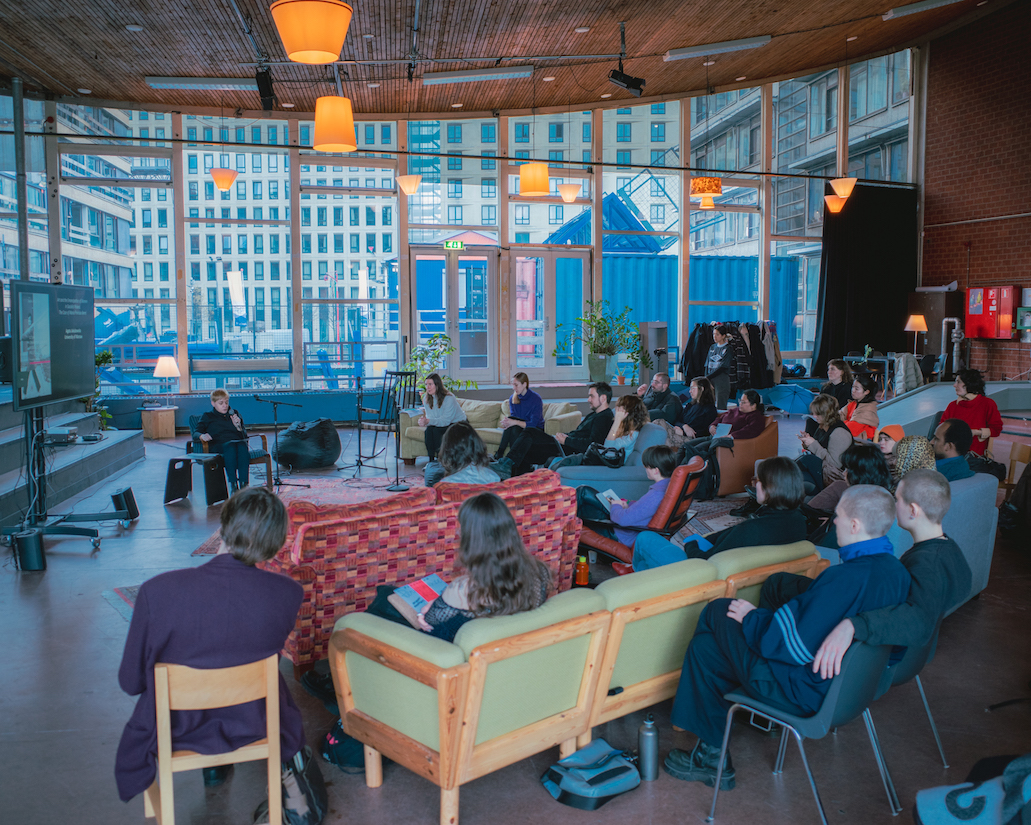
Lecture by Agata Jakubowska
This reflection is at the basis of Orczyk’s research framework, namely her interest in looking at gender equality in the art world in the socialist regime in Poland and now. Gender equality was one of the priorities of the communist and socialist political agendas – everyone had access to childcare, abortion was legal, and women could take long-term maternity leave without fear of losing their jobs. However, although these regimes stood for equality Orczyk started to wonder if that was really the case: ‘Although things were formally arranged, this did not mean that gender equality also existed behind closed doors. A traditional division of roles was still very much in place.’ This also applied to the art world – while men could dedicate most of their time to their art, female artists found themselves juggling work, family, and household chores.
It is important to know that during the socialist regime, and due to isolation from the West, people didn’t talk about feminism; instead, artists addressed what they considered to be ‘women’s topics’. For her PhD research into performance art as (political) resistance, Orczyk looks into the artistic practice of five Polish female performance artists whose work revolves around the position of women: Natalia LL (1937-2022), Zofia Kulik (1947), Ewa Partum (1945) and Maria Pinińska-Bereś (1931-1999). All these artists were active during the period of the Polish People’s Republic (1945-1989) and two of them are still active today. ‘Through archival research and studio visits, I want to investigate the context and conditions in which these artists worked from the 1960s to the Fall of the Berlin Wall.’ Orczyk is still in the beginning phase of her research but already has several questions she would like to find the answers to, for example: What function did performance art have and why did these artists choose this form? To what extent could they be critical? What changes have they experienced since the fall of the Wall? How do current circumstances influenced by right-wing nationalist ideals compare to those when they started their artistic careers? And what advice would they give the younger generation of artists? Orczyk also wants to get in touch with the young generation of Polish performance artists to see what themes they address and how they view and relate to the older generation of artists.
A symposium on artist Maria Pinińska-Bereś and the role of re-enactments
As part of her PhD curatorial research, Orczyk organised a symposium on performance art as female resistance at De Appel in Amsterdam last November. The space had an inviting, and retro feel to it – a coffee corner, sofas and lounge chairs from the previous curatorial project added to the relaxed atmosphere. The event gathered around fourty people, most of them active in the cultural sector and with a Polish background, but it also counted a few Dutch and international art students and artists.
Orczyk believes that analysing the artistic practices of the four artists at the core of her research can provide us with unique insights into the role of performance art as a (political) tool in connection to feminism, as well as the position of female artists. For this symposium, and in a time when female autonomy seems to be threatened once again, Orczyk invited four female researchers to elaborate on the relevance of performance in art history, but also on the position of Maria Pinińska-Bereś and that of other female artists in the socio-political context before and after the fall of the Wall.
The first contributor was Eszter Szakács, curator, researcher, and PhD candidate at the University of Amsterdam. Szakács gave a retrospective talk on Works and Words International Art Manifestation, a 10-day exhibition organised by De Appel in 1979. This event, hosted in different locations in Amsterdam, hoped to bridge East and West and included artworks by 80 artists from the Netherlands and Eastern Europe including installations, videos, performances, and works of conceptual photography. Although its aim was to facilitate an exchange of ideas, it was not very well received. Besides poor attendance, many of the visitors did not relate to the artworks on view. Szakács drew attention to the need to take context into account when looking at artists and their practices. The audience’s lack of knowledge of Eastern European contexts hindered their understanding of and engagement with the artworks displayed. The good news is that this event left behind a rich archive consisting of videos and catalogues, but also correspondence between the various artists and De Appel curators which have been compiled in the publication Works and Words.
Amy Bryzgel, teaching professor of Art History at Northeastern University in Boston, provided an overview of performance art in Eastern Europe in the 1970s and 1980s and highlighted the relevance of re-enactments, or in her words, re-performances, as vehicles of cultural memory: ‘Re-enactments of artistic performance can function, in the region, as witnesses to the forgotten past.’ Bryzgel shared several examples with the audience which included re-enactments by Marina Abramovic, Barbora Klimova, Tomislav Gotovac, Eleanor Anton and Natalia LL. This attested to the variety inherent to using and presenting re-enactments, and how time and context can alter the perception and strength of the artwork.
Agnieszka Sosnowska, curator and assistant professor at the Institute of Art of the Polish Academy of Science, addressed the challenges of creating engaged art and the meaning of radical gestures during the communist era. Sosnowska’s lecture, based on her book Performans opuru (Resistance Performance) published in 2018, shared examples of social and artistic performative actions in Polish history to show how resistance performance as a category blurs the line between social and artistic dimensions. When it comes to gender equality it is worth noting that although her book elaborates on female performance art, it only includes one interview with a female artist; the other female interviewees didn’t want the interviews to be published as they believed readers were not yet ready for what they had to say. Sosnowska gave the audience an insight into Polish female performance art by describing four artworks by renowned Polish female artists and putting them in context. She ended her lecture by questioning whether art should provide an immediate reaction to social and political developments. Can art change reality? Sosnowska sees this as unrealistic: ‘We shouldn’t have such expectations of art’.

From left to right: Dorothé Orczyk, Agata Jakubowska and Agnieszka Sosnowska
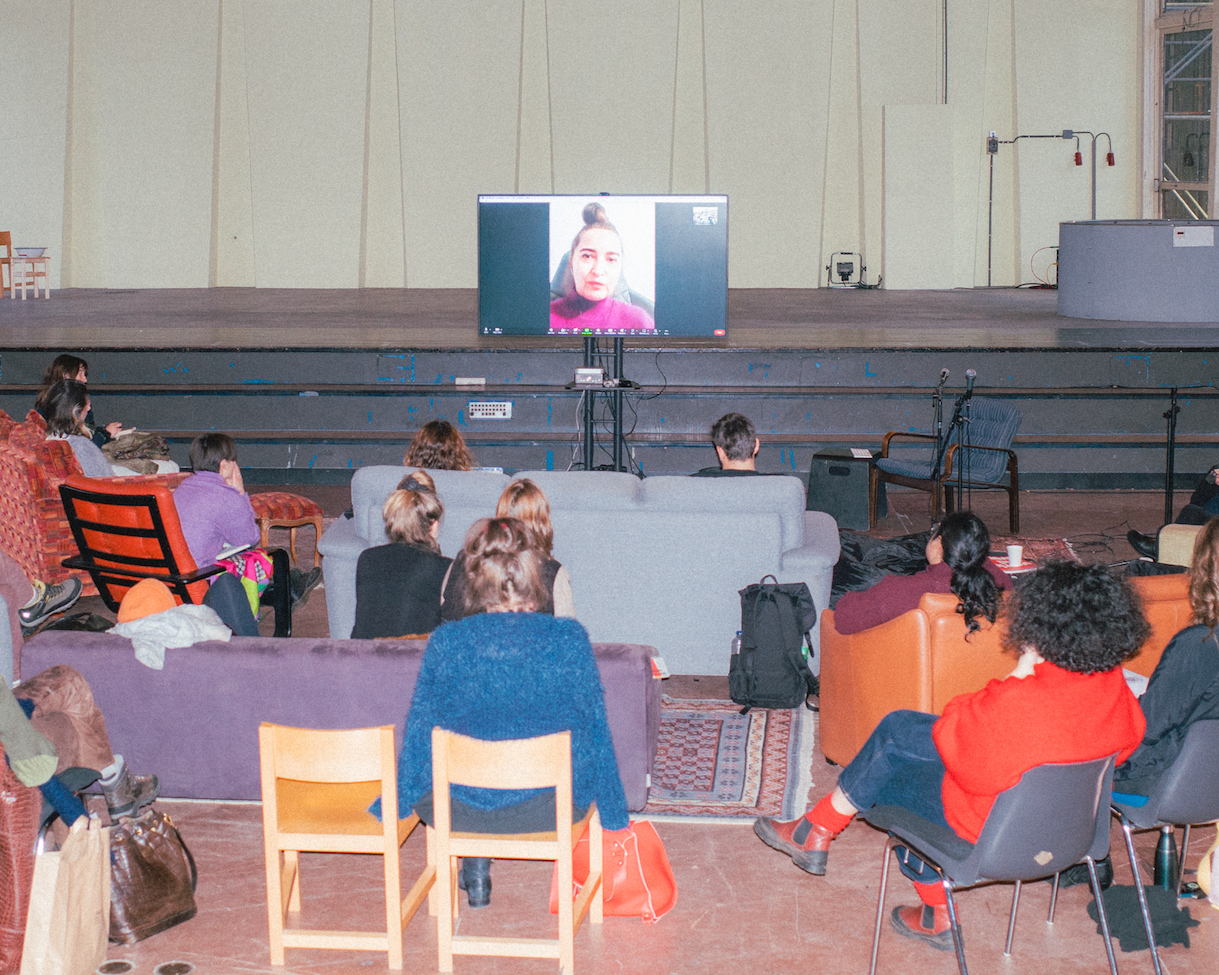
Anka Leśniak engaging with the audience during the Q&A
Artist-researcher and curator Anka Leśniak’s contribution included video excerpts of Fading Traces, a project she carried out in 2010 with the collaboration of seven female artists: Ewa Partum. Anna Kutera, Izabella Gustowska, Krystyna Piotrowska, Teresa Murak, and Teresa Tyszkiewicz. The testimonials of these women offer a vivid insight into the Polish art scene in the 1970s, from a female perspective. Looking back on their artistic careers, they reflect on the challenges and restrictions they faced under the communist regime as female artists.
Agata Jakubowska, associate professor of Art History at the University of Warsaw, dedicated her lecture to Maria Pinińska-Bereś and her role in addressing women’s issues in Poland under the socialist regime. Jakubowska sees ‘local discourse as a crucial source of inspiration for art made by women artists.’ When talking about the work of Maria Pinińska-Bereś, Jakubowska stressed how certain aspects of the work of this artist, for instance, eroticism, cannot be explained by Western standards; instead, we must look at this from a local lens and link it to erotic dissatisfaction women in socialist Poland experienced, among other things. Today we would describe Pinińska-Bereś’s art as feminist, but it was not seen as such in the 1970s – back then, she was considered a creator of women’s art. Jakubowska notes that feminist art was perceived as more critical than feminine art. Pinińska-Bereś said all her art was related to femininity. She valued the autonomy of art and how it allowed her to connect to her feminine essence, instead of being diluted in political stances associated with feminism.
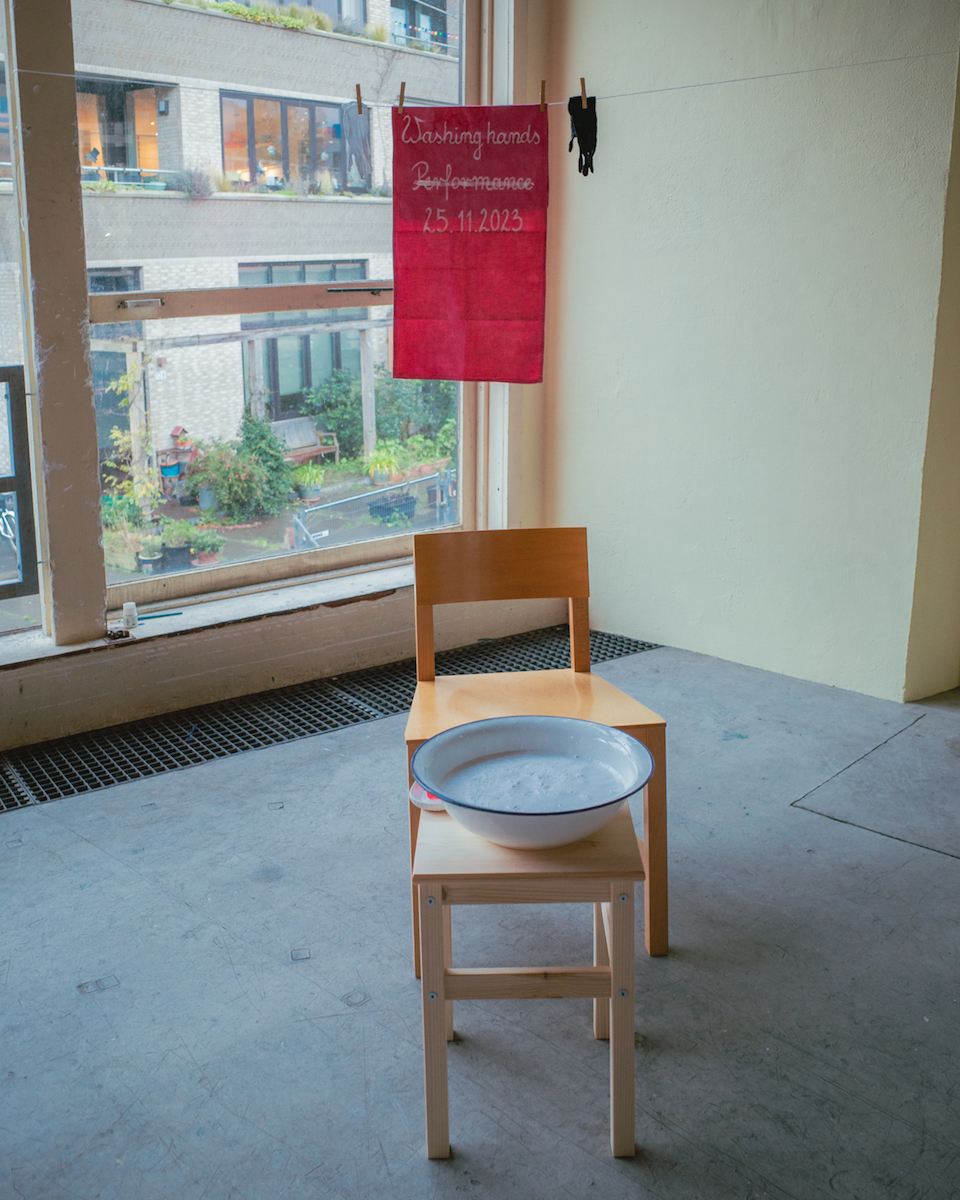
Bettina Bereś reenactment of Washing Hands, end of performance
Bettina Bereś’s re-enactment of her mother’s performance Washing Hands from 1986 closed the event. The audience gathered on the stage to watch the re-enactment of this performance from close by. It was a beautiful experience. Maria Pinińska-Bereś created Washing Hands to express the desire to cleanse art and life of the ‘greaves’. Pinińska-Bereś never expected her performances to be re-enacted, so she never wrote a script for her work. In her introductory speech, Bettina Bereś said she sees the re-enactment of her mother’s performances as a tribute to her legacy.
Bettina Bereś’s re-enactment of her mother’s performance Washing Hands from 1986 closed the event. The audience gathered on the stage to watch the re-enactment of this performance from close by. It was a beautiful experience
In the end, a general Q&A session led to interesting discussions. Orczyk questioned the impact of the female artists in question on the young generation. In Jakubowska’s view, young artists are not interested in art of the 1970s and 1980s because contemporary performance art revolves around community and collaboration. The current focus on the collective does not resonate with the individual actions carried out by artists in the past. When asked about the role of art in resistance, Sosnowska remained sceptical: ‘Everything was political at the time. Would these artists have used the term resistance?’ Jakubowska calls it ‘positive resistance’ instead, as female artists tried to push boundaries by performing simple, everyday actions. They reacted to their context, which was the only one they knew.
What the future holds
When I asked Orczyk about the relevance of her research in our day and age, she replied: ‘For most Dutch people, Poland remains a distant country. What happens there is not seen as relevant. But since the war in Ukraine, people have realised that it is closer than we think. Also, many topics that Eastern European countries face can become issues here, take abortion for instance. We should be aware of the freedom we have and ensure we don’t lose it.’
The symposium took the audience on a journey through female (resistance) performance art and showed the strength of everyday actions and re-enactments in socialist and post-communist Poland. It answered some questions and raised others. In the coming years, Orczyk’s research will continue to critically contribute to redefining the art canon by reclaiming the position of Polish women in it.
-All images by Nikola Lamburov-
Isabel Ferreira de Sousa
is schrijver en doceert aan Maastricht Institute of the Arts